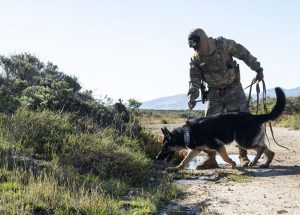Working dog trains

The 30th Security Forces Squadron Military Working Dog Flight conducted a roadway detection training April 15 at Vandenberg Air Force Base.
During the training, the squadron’s military working dog and handler teams faced a test of endurance and readiness as they rucked approximately 2 miles from the kennels toward Wall Beach and back.
“The ruck helps handlers understand the dog’s fatigue level,” said Staff Sgt. Stephen Sanchez, who also works as a trainer. “Handlers can be dispatched at any moment to a threat and need to know how long their dog can effectively work before needing to take a break.”
Before the ruck, each handler geared up with equipment vests, helmets, water, for both them and their dog, an arrangement of leashes, a thermometer to check their dog’s temperature, a muzzle and toys. With the dogs prepared and equipment in hand, the teams began their journey.
Once teams reached the halfway point, they were faced with a simulated roadway training exercise, where six training explosive ordinance devices were buried for the teams to find. Each team was evaluated on its ability to efficiently detect the roadside explosives.
“You never know what you’ll be tasked to do,” said Senior Airman Ricky Wilson, who also works as a handler. “The rucks keep us prepared for a deployment, as well as being able to work as a team under difficult circumstances where the stakes are raised.”
In order to maintain their mission-readiness, each training is designed to simulate situations that might occur at home station, while deployed, or when supporting Secret Service missions, according to Sanchez. During these situations, the team’s ability to come together is vital for the success of the mission and to save lives.
“A dog doesn’t understand that what he’s practicing for could save his handler’s life, or possibly others’ lives,” Sanchez said. “He knows that if he finds an odor, he gets rewarded, but big picture is he’s saving lives.”


 When Luke Hengen’s diabetes worsened in his early twenties, it stripped him of the outdoor activities where the country kid felt at home. Countless wilderness adventures and years of hard-fought football games took a toll on his body, to the point where he could no longer sense when his blood sugar was too high or […]
When Luke Hengen’s diabetes worsened in his early twenties, it stripped him of the outdoor activities where the country kid felt at home. Countless wilderness adventures and years of hard-fought football games took a toll on his body, to the point where he could no longer sense when his blood sugar was too high or […] When middle school students return to class on Jan. 11, they’ll find a new face at the door: Daisy. Daisy is a therapy dog and the personal pet of Rob Kreger, principal of the Rock L. Butler Middle School. The five-year-old golden retriever is not a school pet or mascot, but rather a working dog […]
When middle school students return to class on Jan. 11, they’ll find a new face at the door: Daisy. Daisy is a therapy dog and the personal pet of Rob Kreger, principal of the Rock L. Butler Middle School. The five-year-old golden retriever is not a school pet or mascot, but rather a working dog […] Last March, Caroline Benzel, a third-year medical student, began to notice the stress and discomfort her nurse friends were feeling from the pressures of the ongoing Covid-19 pandemic. “[Personal protective equipment] can be really rough on the skin,” Benzel, 31, tells PEOPLE. Benzel and her 3-year-old Rottweiler, Loki (who’s also a therapy dog) hatched a […]
Last March, Caroline Benzel, a third-year medical student, began to notice the stress and discomfort her nurse friends were feeling from the pressures of the ongoing Covid-19 pandemic. “[Personal protective equipment] can be really rough on the skin,” Benzel, 31, tells PEOPLE. Benzel and her 3-year-old Rottweiler, Loki (who’s also a therapy dog) hatched a […] When Stanley the miniature fox terrier’s owner passed away, the little dog started a ‘paw-some’ new role – bringing puppy love to some of the Gold Coast’s oldest residents. After Carinity Cedarbrook Diversional Therapist Julianne Staff adopted Stanley, he began visiting the aged care community at Mudgeeraba as a therapy dog. Therapy dogs help to […]
When Stanley the miniature fox terrier’s owner passed away, the little dog started a ‘paw-some’ new role – bringing puppy love to some of the Gold Coast’s oldest residents. After Carinity Cedarbrook Diversional Therapist Julianne Staff adopted Stanley, he began visiting the aged care community at Mudgeeraba as a therapy dog. Therapy dogs help to […] A nonprofit is providing an unusual form of therapy for those on the front lines of the coronavirus pandemic – puppy cams! “You spend five minutes with a puppy and try not to smile,” said registered nurse Robin Lingg Lagrone. Lingg Lagrone says watching little furballs wag their tails and prance on their paws helps […]
A nonprofit is providing an unusual form of therapy for those on the front lines of the coronavirus pandemic – puppy cams! “You spend five minutes with a puppy and try not to smile,” said registered nurse Robin Lingg Lagrone. Lingg Lagrone says watching little furballs wag their tails and prance on their paws helps […] When Moore County’s school doors were abruptly closed earlier in 2020, two- and four-legged volunteers from the Moore County Citizens’ Pet Responsibility Committee (PRC) were in their 12th year of presenting a six-session Pet Responsibility Education Program for fourth-graders. The PRC quickly shifted gears and placed its program materials online as part of a home […]
When Moore County’s school doors were abruptly closed earlier in 2020, two- and four-legged volunteers from the Moore County Citizens’ Pet Responsibility Committee (PRC) were in their 12th year of presenting a six-session Pet Responsibility Education Program for fourth-graders. The PRC quickly shifted gears and placed its program materials online as part of a home […]